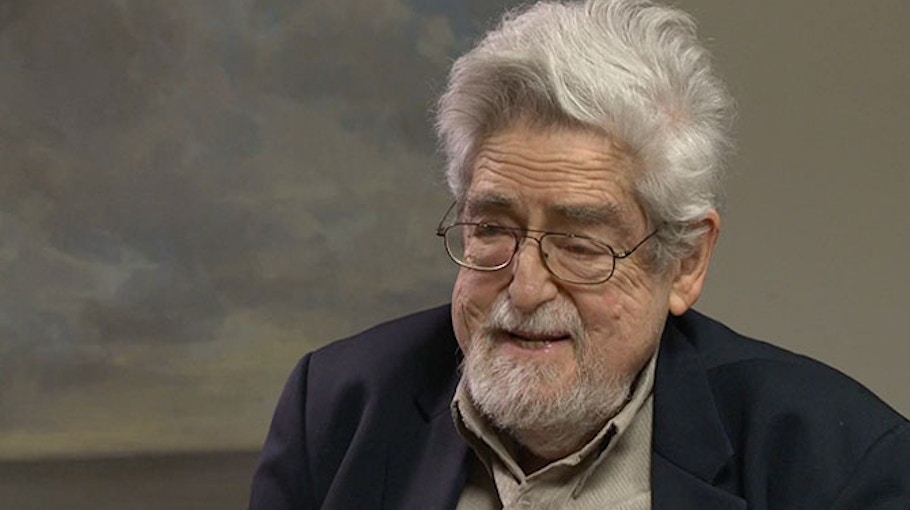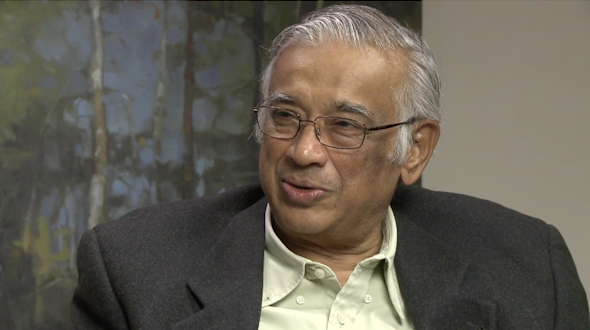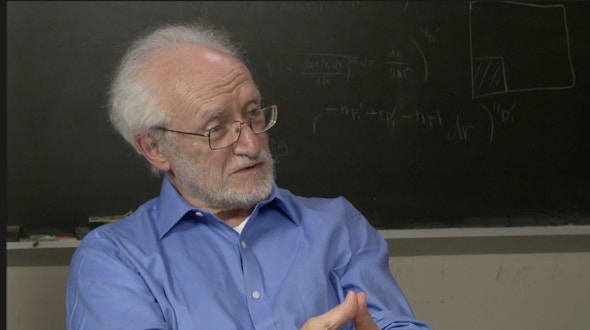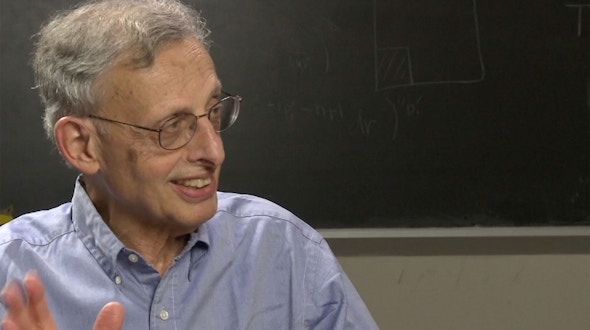Louis Nirenberg
- Interview Highlights (2:53)
- Inclination Towards Mathematics (1:02)
- Studies at McGill and NYU (3:04)
- Thesis on a Problem of Hermann Weyl (2:11)
- Maximum Principles and The Method of Moving Planes (3:47)
- Nirenberg Problem and Other Geometric Problems (5:02)
- Nash Embedding Problem (2:16)
- Newlander-Nirenberg Theorem (3:37)
- Lewy Problem (2:31)
- The Weierstrass-Malgrange Preparation Theorem (3:48)
- From Complex Analysis to Pseudodifferential Operators (3:38)
- PDE's (5:54)
- Current State of PDE's (3:23)
- Work on Free Boundary Problems (1:22)
- Collaboration with Luis Caffarelli (4:44)
- Collaboration with Henri Berestycki and Caffarelli (3:16)
- BMO and VMO (3:44)
- Papers with Hartman, Lax, and Varadhan (2:48)
- Connection to Italy (3:53)
- Early Visits to Russia and China (4:43)
- Attending Gelfand's Seminar in 1963 (5:00)
- Linear and Nonlinear PDEs (1:50)
- Algebra of Pseudodifferential operators (2:22)
- Choosing Problems and Giving Geminars (4:44)
- Working with Students (1:25)
- The Culture of the Courant Institute (5:15)
- Stealing Peter Lax's Jokes (1:45)
- Nirenberg Keeping up with Mathematics (3:08)
- The Value of Collaboration (2:33)
- Contemporary Mathematics and Physics (3:41)
- Prizes (3:14)
Louis Nirenberg was born in 1925 in Hamilton, Ontario, and was raised in Montreal; in both places his father was a teacher of Hebrew. The primary home language was Yiddish, which Louis spoke before English. He was of course required to study Hebrew, but at that time learning Hebrew did not interest him very much. However, one of the tutors employed by Louis’ father enjoyed doing math puzzles, and the two of them secretly spent half their time together doing puzzles.
He went to an excellent public high school, called Baron Byng High School, where he had excellent teachers (one even with a Ph. D.) and excellent classmates. He regrets that growing up in Montreal, he never had a French-speaking friend. The English speakers and French speakers hardly mixed, and the Jewish community was a tight-knit subset of the English speakers.
He went to McGill University to study math and physics. He remembers Gordon Pall as an outstanding mathematician at McGill. Nirenberg was not drafted during World War II, because Canada had a policy of not drafting science students.
After completing his bachelor’s degree at McGill, he took a summer job with the National Research Council of Canada. The work was actually on the atomic bomb, subcontracted from the Manhattan Project in New Mexico, and a fellow worker was the physicist Ernest Courant, a son of Richard Courant, at that time a Professor at New York University. Ernest mentioned to Louis that he was going to New York to see Papa Courant, so Louis asked him to request advice as to where to apply for graduate work in physics. He returned with Richard Courant’s invitation to Louis to come to NYU for a master’s degree in math; then Louis would be ready for a physics program. But once Louis started in math at NYU, he never left. He took a Ph. D. under James Stoker, solving a famous open problem in geometry. He stayed on as a post-doc, then as a faculty member.
Richard Courant did not obey the usual rule, “a fresh Ph. D. should move on to a different environment.” On the contrary, he kept his best students, including Louis Nirenberg, to create the world famous faculty at his Institute at NYU.
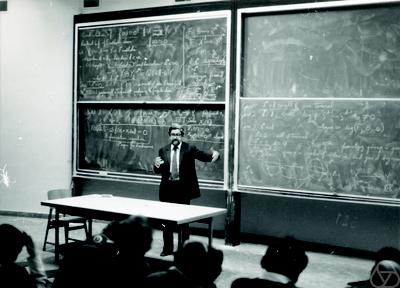
The problem he received from Stoker is called “the embedding problem”. Roughly speaking, given a distance function defined on the 2-dimensional sphere (so that at every point the sphere is convex), can one construct a surface in three-dimensional space so that this distance function s that inherited from the normal distance in R3? The great German mathematician Hermann Weyl had made a significant start on this many years before, and Nirenberg as a student completed Weyl’s construction. The work involved solving a system of nonlinear equations of the type called “elliptic”, and it has been precisely on solving equations of this type that Louis Nirenberg has been working most of the time ever since.
Interesting problems in partial differential equations rarely can be solved by an explicit formula. The solution has to be by some sort of approximation, and the essential point is usually to show that a proposed approximation procedure actually converges to a solution. An elaborate machinery from topology and functional analysis is now available to prove such convergence, provided only that certain estimates are available to control the approximation. For the classical equations of equilibrium in continuum mechanics, which are known as the Laplace and Poisson equations, there is a classic “maximum principle” that provides the needed estimate. In fact, Nirenberg is quoted as saying, whether in jest or in earnest, “I have made a living off the maximum principle.” However, there are also many other kinds of estimates that one may need to use. Most common are estimates of the integrals of the functions in question, along with a certain number of their derivatives (called “Sobolev estimates.”). These functions and their integrals may be squared or taken to other powers before integration, and they may be integrated against appropriate “weight functions.” Proving the strongest possible estimates is the technical essence of the modern theory of partial differential equations.
When Nirenberg came to NYU, the most active leading researcher there was Kurt Otto Friedrichs, and Friedrichs was the strongest influence on Nirenberg’s future research career. Friedrichs loved inequalities better than identities. (“Inequalities” means the same thing as “estimates.” An inequality is just a formula saying one thing is smaller than another.) Nirenberg has long been known as a world master of inequalities. For many years, mathematicians came from everywhere to seek his counsel on questions about inequalities. True, they sometimes had made errors in their calculations, but Nirenberg had a nose for their errors! Now, in his 80’s, he makes errors himself, and has to correct them before publication.
Nirenberg has lived in New York ever since 1949, on the Upper West Side, and he loves his apartment, his neighborhood and his city. He also loves to travel. He is particularly in love with Italy. He recalls with great pleasure his first professional visit there, at a meeting where he met the young Italian specialists in partial differential equations, all of whom he found to be wonderful people. He talks with great pleasure of the Italian cities he loves: Rome, Milan, Pavia, Pisa, Venice, Naples….He was a happy participant in the first big Soviet-American joint mathematics conference, which took place in 1963 in Akademgorodok (in Novosibirsk.) It was organized by Richard Courant and Mikhail Lavrentiev, on partial differential equations. There were a couple of dozen from the U.S., and about 120 from the Soviet Union. He says it was wonderful, like being on an ocean voyage where you get to know many new friends intimately.
Louis thrived on interaction with other researchers; over 90% of Nirenberg’s papers have been written jointly. One of the most important was co-authored with Avron Douglis and Shmuel Agmon. The classical theory had concentrated on equations of second order. Agmon, Douglis and Nirenberg succeeded in solving equations of degree 3 and higher. To accomplish this, they used a new tool called “singular integral operators” that had recently been developed by two Chicago mathematicians, Alberto Calderon of Argentina and Antoni Zygmund of Poland. The great difficulty was estimating the solution at points very close to the boundary. This was the main thing that Agmon, Douglis and Nirenberg accomplished. Their results became a permanent principal tool for all future work in the area.
Another famous paper of Nirenberg’s was written together with Joe Kohn, of Princeton University. Again they turned to the singular integral operators of Calderon and Zygmund for the needed estimates. Calderon and Zygmund had provided the estimate for a product of two singular integral operators. But Kohn and Nirenberg needed to use all the sums and products of these operators. They needed to show that they behaved algebraically like decent sums and products , except for lower order terms which could be precisely expressed. They called the resulting mathematical structure “pseudo-differential operators.” In order to solve a specific given problem, they had been led to create a whole new structure and theory that quickly became an important tool in advanced work on partial differential equations.
Together with Fritz John, he introduced the notion of “bounded mean oscillation (BMO).” That is the condition that a function has an average or “mean” value, and that the sum of all the variations from that mean is finite. The space of BMO functions is fundamentally important for the analysis of the space of bounded continuous functions.
An influential paper of Nirenberg’s was jointly written with his student August Newlander. They answered a question raised first by the great French number theorist André Weil and then again by the famous geometer Shiing-Shen Chern. The problem was to reduce a given system of first order linear partial differential equations to standard equations of several complex variables.
Nirenberg received the Bocher Prize of the American Mathematical Society in 1959. In 1982 he shared with Vladimir Arnol’d the first Crafoord Prize—it was in mathematics–established by the Royal Swedish Academy of Science in areas not covered by the Nobel Prizes. In 1994 he won the Steele Prize for Lifetime Achievement of the AMS. In 1995 he received the National Medal of Science of the U.S. In 2010 he was awarded the inaugural Chern Medal , given for the first time by the International Mathematical Union and the Chern Medal Foundation, “to an individual whose accomplishments warrant the highest level of recognition for outstanding achievements in the field of mathematics.” The medal is named after the famous Chinese geometer Shiing-Shen Chern, with whom Nirenberg is proud to have written one joint paper, along with Harold Levine.
He concluded one interview by saying, “I must say all the people I’ve worked with have been extremely nice. It’s one of the joys of working with colleagues. Peter Lax seems like a brother to me. One paper with Philip Hartman was elementary but enormous fun to do. That’s the thing I try to get across to people who don’t know anything about mathematics, what fun it is! One of the wonders of mathematics is you go somewhere in the world and you meet other mathematicians and it’s like one big family. This large family is a wonderful joy.”
Nirenberg’s mathematical family includes his 45 Ph. D. students, and 255 mathematical descendents. His biological family includes a son and a daughter, a grandson who is a jazz drummer studying at the Juilliard School of Music, and a grand-daughter who is also musically talented. His companion, who worked in an art gallery, keeps her Paris apartment, where they often go to visit her family and friends.
REFERENCES
Simon Donaldson, March 2011, “On the Work of Louis Nirenberg,” Notices of the American Mathematical Society, 58 (3), 469-472
Allyn Jackson, April 2002, “Interview with Louis Nirenberg,” Notices of the AMS, 49 (4), 441-449
Yan Yan Li, 2010, “Work of Louis Nirenberg,” Proceedings of the International Congress of Mathematicians, Hyderabad, India
